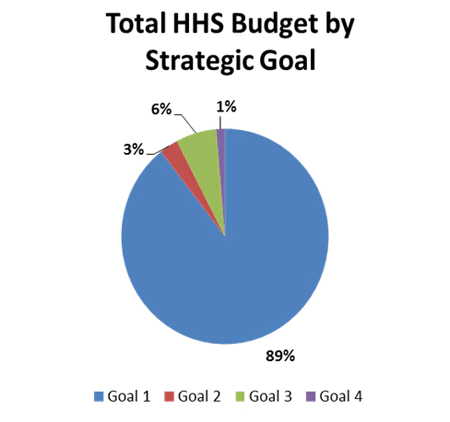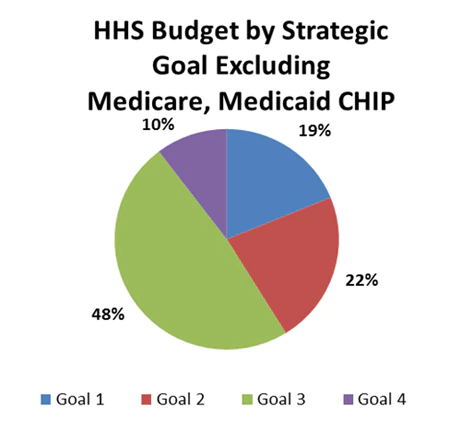Read the print version of the report: FY 2015 Summary of Performance and Financial Information
Every four years HHS updates its strategic plan, which describes its work to address complex, multifaceted, and evolving health and human services issues. An agency strategic plan is 1 of 3 main elements required by the Government Performance and Results Act of 1993 (GPRA) and the GPRA Modernization Act of 2010. The Department’s Strategic Plan (Plan) defines its mission, vision, goals, and the means by which it will measure its progress in addressing specific national problems over a four-year period. In addition, each of the Department’s Operating Divisions (OpDivs) and Staff Divisions (StaffDivs) contribute to the development of the strategic plan, as reflected in the Plan’s strategic goals, objectives, strategies, and performance goals.
The FY 2014 – 2018 HHS Strategic Plan describes the Department’s efforts within the context of broad strategic goals. This Plan identifies four strategic goals and 21 related objectives. The four strategic goals are:
Goal 1: Strengthen Health Care
Goal 2: Advance Scientific Knowledge and Innovation
Goal 3: Advance the Health, Safety, and Well-being of the American People
Goal 4: Ensure Efficiency, Transparency, Accountability, and Effectiveness of HHS Programs
The strategic goals and associated objectives focus on the major functions of HHS. Although the strategic goals and objectives in the Plan are presented as separate sections, they are interrelated, and successful achievement of one strategic goal or objective can influence the success of others. For example, the application of a promising new scientific discovery (Strategic Goal 2) can affect the quality of health care patients receive (Strategic Goal 1) and/or the success of human service programs (Strategic Goal 3). Improving economic well-being and other social determinants of health (Strategic Goal 3) can improve health outcomes (Strategic Goal 1). Responsible management and stewardship of federal resources (Strategic Goal 4) can create efficiencies the Department can leverage to advance its health, public health, research, and human services goals. For the second consecutive year, HHS conducted an annual Strategic Review, which consisted of various senior Department leaders reviewing performance data, evidence, and other factors for the 21 objectives. The annual review allows HHS leadership to undertake a high-level look at results, challenges, and future initiatives across the Department.
It is helpful to look at how HHS invests resources toward fulfilling the Department’s mission through its strategic goals. Below are two charts that show the proportion of financial resources that are primarily dedicated to achieving each strategic goal.
Although HHS funding in the charts is broken down into strategic goals, many of the programs in HHS are crosscutting in nature and support a number of strategic goals. The chart on the left provides the breakdown of the HHS budget by strategic goal. The majority of the Department’s funding was primarily associated with Goal 1 because of the large amount of money invested in delivering quality care and services through Medicare, Medicaid, and the Children’s Health Insurance Program (CHIP). For FY 2014, of the four strategic goals, 89 percent was spent on Goal 1, 3 percent on Goal 2, 6 percent on Goal 3, and 1 percent on Goal 4.
The chart on the right illustrates the HHS budget excluding the costs of Medicare, Medicaid, and CHIP. Of the four strategic goals excluding Medicare, Medicaid, and CHIP, 19 percent was spent on Goal 1, 22 percent on Goal 2, 48 percent on Goal 3, and 10 percent on Goal 4.


HHS uses Agency Priority Goals (APGs), also referred to as HHS Priority Goals, to improve performance and accountability. HHS developed APGs by collaborating across the Department to identify activities that would reflect HHS priorities. We utilized the knowledge we gained through collaboration and during data-driven reviews to develop our APGs. These goals are a set of ambitious, but realistic performance objectives that the Department will strive to achieve within a 24-month period. APGs are a limited number of specific performance targets that advance progress toward longer-term outcomes. HHS engaged in five APGs for FY 2014 – FY 2015 that supported the achievement of our strategic goals:
- Improve Patient Safety
- Improve Health Care through Meaningful Use of Health Information Technology
- Improve the Quality of Early Childhood Education
- Reduce Combustible Tobacco Use
- Reduce Foodborne Illness in the Population
HHS performance initiatives, including APGs, continue to influence plans and policies as demonstrated in the Department’s Plan, which guides our efforts into the future. The most recent data, accomplishments, and future actions on HHS APGs, as well as information on previous APG cycles, can be found on www.performance.gov. The website provides information on the measures and milestones used by HHS to monitor progress toward these goals.
In addition to the APGs and strategic reviews, HHS reported data on 144 key performance measures in its FY 2016 HHS Annual Performance Plan and Report. These measures represent important issue areas being addressed by the health care and human services communities. The performance measures present a powerful tool to improve HHS operations and help to advance an effective, efficient, and productive government. HHS regularly collects and analyzes performance data to inform decisions. While HHS does not yet have FY 2015 data available for all measures due to the lag associated with data collection and reporting, HHS’s OpDivs and StaffDivs constantly strive to find lower-cost ways to achieve positive impacts in addition to sustaining and fostering the replication of effective and efficient government programs. For more information on results from FY 2015 and earlier, including trend data for individual measures, please consult the HHS Annual Performance Plan and Report, released annually in February along with the President’s Budget, which can be found here.
The following sections provide more information on each Strategic Goal and highlights accomplishments across the Department in FY 2015 with success stories from our Operating and Staff Divisions, in addition to the collaborative accomplishments achieved through the Agency Priority Goals.
Topics in this report
- Goal One: Strengthen Health Care
- Goal Two: Advance Scientific Knowledge and Innovation
- Goal Three: Advance the Health, Safety, and Well-Being of the American People
- Goal Four: Increase Efficiency, Transparency, and Accountability of HHS Programs
- Summary of Financial Statements and Stewardship Information

